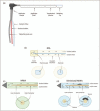Thermal ablation in adrenal disorders: a discussion of the technology, the clinical evidence and the future
- PMID: 33741778
- PMCID: PMC8183491
- DOI: 10.1097/MED.0000000000000627
Thermal ablation in adrenal disorders: a discussion of the technology, the clinical evidence and the future
Abstract
Purpose of review: To summarise the emerging role of thermal ablation as a therapeutic modality in the management of functioning adrenal tumours and metastases to the adrenal gland.
Recent findings: Observational evidence has demonstrated the benefit of thermal ablation in (i) resolving adrenal endocrinopathy arising from benign adenomas, (ii) treating solitary metastases to the adrenal and (iii) controlling metastatic adrenocortical carcinoma and phaeochromocytoma/paraganglioma.
Summary: Microwave thermal ablation offers a promising, minimally invasive therapeutic modality for the management of functioning adrenocortical adenomas and adrenal metastases. Appropriate technological design, treatment planning and choice of imaging modality are necessary to overcome technical challenges associated with this emerging therapeutic approach.
Copyright © 2021 The Author(s). Published by Wolters Kluwer Health, Inc.
Conflict of interest statement
Figures



References
-
- Wolfram F, Lesser T. A simulation study of the HIFU ablation process on lung tumours, showing consequences of atypical acoustic properties in flooded lung. Z Med Phys 2019; 29:49–58. - PubMed
-
- Ito T, Shoji O, Nagamine S, et al. . Radiofrequency ablation of breast cancer: a retrospective study. Clin Breast Cancer 2018; 18:495–500. - PubMed
-
- Chini EN, Brown MJ, Farrell MA, et al. . Hypertensive crisis in a patient undergoing percutaneous radiofrequency ablation of an adrenal mass under general anesthesia. Anesth Analg 2004; 99:1867–1869. table of contents. - PubMed
Publication types
MeSH terms
LinkOut - more resources
Full Text Sources
Other Literature Sources
Medical
Research Materials

